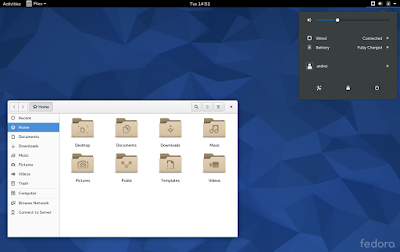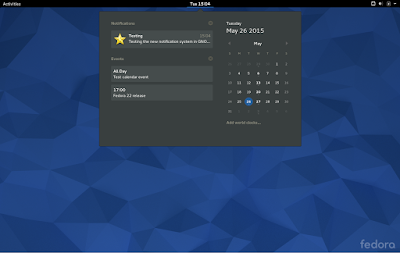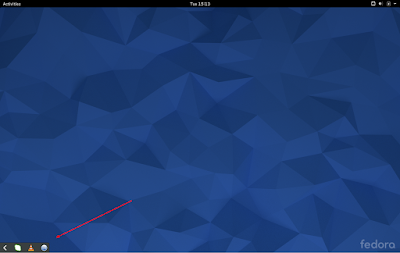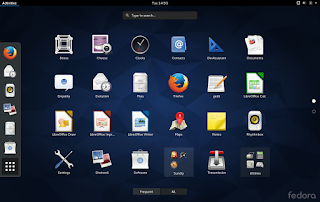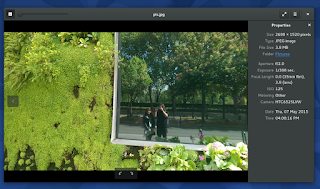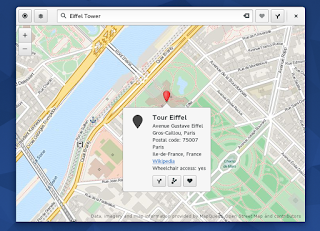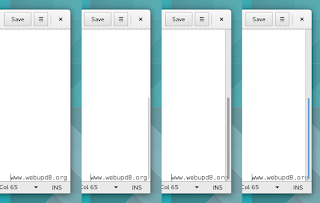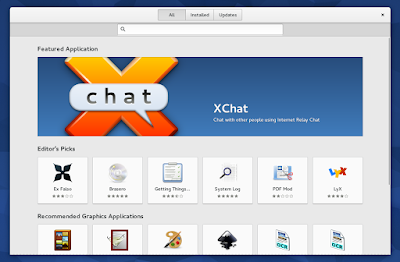Fedora 22 Workstation was released today and it ships with the latest stable GNOME 3.16, a new default package manager and other interesting changes. Let's take a look at what's new!
GNOME 3.16
Fedora 22 Workstation ships with GNOME 3.16 by default and the most important change in this release is probably the new notification system, which has replaced the old Message Tray.
In GNOME 3.16, the notification history can now be accessed from the date/time menu (the calendar widget from the Top Bar):
... while legacy "tray" icons are displayed in an expandable "drawer" that uses autohide and it's available in the bottom left corner of the screen:
Furthermore, the notification popups, called "banners", are now displayed at the top of the screen:
In the screenshot above you should notice a dot next to the date/time indicator - this indicates unread notifications.
Other changes in GNOME 3.16 include:
- refreshed GNOME Shell theme (including monochrome icons for the applications menu);
- scrollbars are displayed only when needed (see screenshot below);
- GTK+ 3.16:
- OpenGL support;
- themes can now simultaneously support multiple GTK+ versions, by including version-specific CSS;
- a new widget called GtkPopoverMenu was added and it can be used for creating menus contained with popovers;
- many GTK+ Inspector changes including a much improved user interface;
- GNOME apps:
- GNOME's Image Viewer has been redesigned and it now uses header bars;
- Files (Nautilus) 3.16 comes with bigger icons/thumbnails by default, reorganized menus, improved grid and list views as well as a new popover for changing between views, zoom level and sort order. Also, with the latest Files app, users can now move files and folders to the trash using the Delete key instead of Ctrl + Delete, like in previous versions;
- Installation of GStreamer codecs, fonts, and certain document types is now handled by Software;
- Maps can now display information bubbles which show the address, wheelchair accessibility along with links to Wikipedia articles. Also, the latest GNOME Maps comes with built-in Foursquare support, which allows you to check-in;
- Calculator now displays previous calculations so you can easily copy previous figures;
- Boxes comes with an updated properties interface, a new menu makes it possible to send keyboard shortcuts that cannot be entered directly into a box and more;
- smart playlists have been added to Music, so you can view frequently played and recently added tracks. It is now also possible to star your favorite tracks;
- two new games were added: a sliding blocks game called Taquin and 2048;
- three new preview applications were added: Calendar (which already comes with Google Calendar sync), Characters (character map application) and Books (e-book viewer) - these are not installed by default in Fedora 22 but are available in the repositories;
- a new IDE for GNOME, called "Builder", is now available as an early preview (it's not installed by default but it's available in the repositories).
See our GNOME 3.16 article for more information (including a video).
Here are a few screenshots with some of the changes mentioned above, taken under Fedora 22 Workstation:
Other changes
Fedora 22 Workstation includes quite a few under the hood changes, including a new default package manager: DNF (under the hood, it uses an improved dependency solver, called hawkey, along with librepo for repository operations and libcomps for package groups), which has replaced Yum.
DNF provides better performance and memory footprint along with a "strict API definition for plugins and extending projects", notes the Fedora 22 release announcement.
DNF provides better performance and memory footprint along with a "strict API definition for plugins and extending projects", notes the Fedora 22 release announcement.
Most DNF commands are similar to Yum (and /usr/bin/yum now redirects to /usr/bin/dnf, with a deprecation notice) and the same RPM package repositories are used however, there are some differences:
- updates that don't work are skipped - this is similar to Yum's "--skip-broken" (which isn't available for DNF), but it evaluates the impact of the problem against the entire transaction;
- repositories that don't work are skipped;
- dependencies are not upgraded on package installation;
- when removing a package, DNF will automatically remove any dependent packages that were not explicitly installed by the user;
- by default, DNF will check for updates in configured repositories hourly, starting ten minutes after the system boots;
- unlike with Yum, DNF allows removing all kernel packages, including running package.
Even more changes:
- the Software tool and PackageKit now support searching for packages in disabled repositories;
- Fedora 22 introduces the Preupgrade Assistant (not installed by default), a diagnostics utility which assesses the system for possible in-place upgrade limitations and provides a report with the analysis results;
- GDM uses Wayland by default, instead of Xorg, bringing the transition to Wayland one step closer. The default GNOME session continues to use X;
- input devices use a new driver: "libinput", which replaces other drivers such as synaptics, and provides improved support for multi-touch devices and software emulated buttons (this is only installed by default on new Fedora 22 installations);
- The default console font has been changed to eurlatgr in Fedora 22. The new font has the same typeface as the previously used latarcyrheb-sun16 font, but supports a broader range of characters from the Latin and Greek alphabets as well as some commonly used symbol;
- The Terminal now notifies you when a long running job completes (this is a Fedora-specific feature, that's why I didn't include it in the GNOME 3.16 changes above).
Default packages
Fedora 22 Workstation ships with Firefox 38.0.1, LibreOffice 4.4.3.2, Shotwell 0.22.0, Rhythmbox 3.2.1, Transmission 2.84, Empathy 3.12.10 along with version 3.16.x of the core GNOME applications (Nautilus, Gedit, Terminal and so on), on top of GNOME Shell 3.16.2 and GTK+ 3.16.3.
Under the hood, Fedora 22 Workstation uses the Linux Kernel 4.0.4, systemd 209, Mesa 10.5.4 and Xorg Server 1.17.1.
Download Fedora 22
Before installing Fedora 22, make sure you check out the common bugs list and the official release notes.
It's also important to mention that three new websites were released along with Fedora 22 today:
- arm.fedoraproject.org - Fedora Images for ARM Computers;
- spins.fedoraproject.org - Alternative desktops for Fedora (KDE Plasma, Xfce, LXDE, MATE-Compiz and SoaS);
- labs.fedoraproject.org - Fedora bundles.
To easily install codecs, Java and various popular apps that aren't available in the Fedora repositories, along with tweaks such as improved font rendering, you can use Fedy, a Fedora post-install utility which was updated to version 4.0 recently and it already supports Fedora 22.
info via

